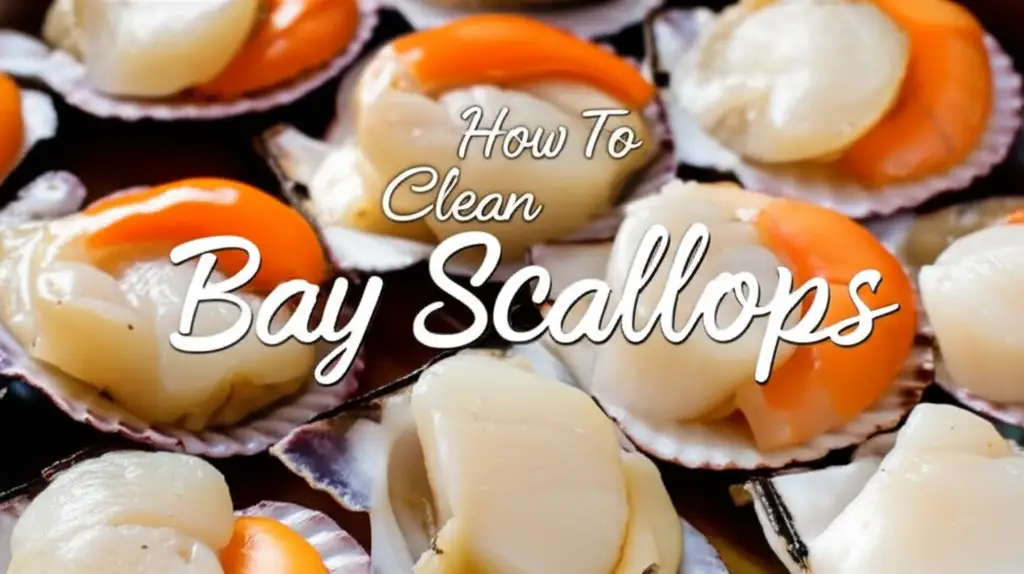· Food Preparation · 15 min read
How To Clean Bay Scallops

How to Clean Bay Scallops: A Simple Guide
Imagine the sweet, delicate taste of perfectly cooked bay scallops. These small, tender morsels offer a true culinary delight. However, reaching that perfect taste requires a crucial first step: proper cleaning. Bay scallops, especially when fresh from the sea or market, often contain sand, grit, or small bits of shell. Ignoring these impurities can ruin an otherwise delicious meal, leaving an unpleasant crunch.
Learning how to clean bay scallops ensures a delightful dining experience. It removes any unwanted elements, leaving only the pure, sweet scallop meat. This preparation step makes your cooking efforts truly shine. In this article, we explore the simple steps to prepare your bay scallops for cooking. We will cover essential tools, cleaning techniques for both shucked and unshucked scallops, and how to store them safely. Get ready to enjoy bay scallops at their very best.
Takeaway
Cleaning bay scallops correctly means:
- Rinsing them thoroughly under cold water.
- Inspecting each scallop for sand, grit, or shell fragments.
- Removing any tough, crescent-shaped muscle if present.
- Drying them completely before cooking.
To clean bay scallops, rinse them under cold water in a colander, gently swirling. Inspect each scallop for grit, sand, or any attached muscle. Pick off unwanted pieces with your fingers or a small knife. Pat them completely dry with paper towels before cooking to achieve a perfect sear.
Understanding Bay Scallops and Why Cleaning Matters
Bay scallops are small, sweet shellfish found in shallow waters along coastlines. They are popular for their delicate flavor and tender texture. People often enjoy them seared, fried, or in pasta dishes. Most bay scallops are sold already shucked, meaning the edible muscle has been removed from its shell. You usually find them in seafood markets or grocery stores, packed in a container with some liquid.
Despite being shucked, these scallops often carry impurities. Sand is a common issue. Tiny grains of sand can cling to the scallops or settle in their container. Shell fragments can also be present, especially if the shucking process was not perfect. Sometimes, a small, crescent-shaped piece of tough muscle remains attached. This muscle is harmless but chewy, affecting the eating experience.
Cleaning scallops removes these unwanted elements. A simple rinse and inspection prevent gritty textures in your meal. It also ensures you only taste the pure, sweet flavor of the scallop. This step is not just about cleanliness; it is about taste and enjoyment. A well-cleaned scallop cooks better and tastes superior. I always make sure this step is done right for the best results.
Essential Tools and Preparations for Cleaning Bay Scallops
Gathering the right tools makes the cleaning process smooth and efficient. You do not need many specialized items, just a few basic kitchen essentials. Having everything ready before you start saves time and prevents mess. A clean workspace is important when handling fresh seafood.
Here is what you will need:
- A colander: This helps drain the water while you rinse the scallops. Look for one with small holes so the scallops do not fall through.
- A large bowl: Place this under the colander to catch excess water or for soaking.
- Paper towels or a clean kitchen towel: These are crucial for drying the scallops thoroughly after rinsing. Drying helps achieve a good sear when cooking.
- A small, sharp knife or paring knife (optional): This is useful if you encounter any stubborn shell fragments or tough muscle. Your fingers often work best for small pieces.
Before you begin, ensure your kitchen surfaces are clean. Wash your hands thoroughly with soap and water. This prevents any cross-contamination. Set up your cleaning station near the sink for easy access to cold running water. A clean kitchen supports fresh food preparation. Just as you ensure your cooking vessels are clean for the best results, like knowing how to clean bottom of pan after a meal, it is vital to start with clean ingredients and a clean environment.
Step-by-Step Guide to Cleaning Shucked Bay Scallops
Most bay scallops bought from a store come shucked. This means the hard part of removing them from their shells is already done. However, they still need a thorough cleaning before cooking. This process is straightforward and takes only a few minutes. I find this simple routine helps me enjoy every bite.
Follow these steps for perfectly cleaned shucked bay scallops:
- Drain the Scallops: Open the package of bay scallops. Pour the scallops and their liquid into a colander. Let any excess liquid drain away.
- Rinse Gently: Place the colander under cold running water. Do not use warm or hot water, as it can start to cook the delicate scallops. Gently swish the scallops around with your hand. This helps dislodge any sand or grit. Rinse for about 30 seconds to a minute.
- Inspect Each Scallop: Turn off the water. Spread the scallops out in a single layer on a clean surface or in the colander. Pick up each scallop one by one. Look for any visible impurities. This includes small bits of shell, dark spots, or grit. Pay close attention to any tiny, crescent-shaped muscle still attached.
- Remove Impurities: If you find any shell fragments, gently pick them off with your fingers. For the small, crescent-shaped muscle, gently pinch it between your thumb and forefinger and pull. It should come off easily. If it is stubborn, use a small paring knife to carefully cut it away. This muscle is edible but has a chewier texture than the rest of the scallop. Removing it improves the eating experience.
- Final Rinse (Optional): If you found a lot of grit, you can do a quick, very gentle second rinse. However, avoid over-rinsing, as it can diminish the scallop’s flavor.
- Dry Thoroughly: This is a crucial step. Lay the cleaned scallops in a single layer on a few layers of paper towels. Gently place more paper towels on top and press down softly. You want to absorb as much moisture as possible. Excess moisture prevents scallops from searing properly, resulting in a steamed texture rather than a golden crust. Repeat with fresh paper towels if needed, until the scallops are very dry to the touch. This step is essential for beautiful, seared scallops.
These steps ensure your bay scallops are clean and ready for cooking. They will be free of grit and have a better texture. This simple process makes a big difference in the final dish.
Cleaning Unshucked Bay Scallops
While most bay scallops are sold shucked, you might encounter them in their shells, especially if you harvest them yourself or buy them directly from a fisherman. Cleaning unshucked scallops involves an extra step: shucking them first. This process can seem daunting, but it is quite manageable with a little practice. I remember my first time shucking; it took a bit, but now it is quick.
Here is how to clean bay scallops when they are still in their shells:
- Prepare the Scallop: Hold the scallop firmly in your hand with the flat side of the shell facing up. The hinge, where the two shells connect, should point towards your thumb.
- Open the Shell: Insert a small, sturdy scallop knife or a thin, flat knife into the hinge. Twist the knife gently to pop the shell open. You may need a bit of force. Once a small opening appears, slide the knife along the inside of the flat shell, staying very close to the shell. This cuts the adductor muscle, releasing the top shell.
- Remove Organs: Carefully remove the top shell. Inside, you will see the adductor muscle (the white, round part you want to eat), and other organs. These include the black digestive sac, gills, and sometimes the orange roe (coral). Use your knife or fingers to scrape away all the dark, soft organs. You want to leave only the white adductor muscle attached to the bottom shell.
- Detach the Adductor Muscle: Slide your knife underneath the adductor muscle, keeping it flush with the bottom shell. Cut the muscle free from the shell. Discard the shell and organs.
- Clean the Muscle: Once the adductor muscle is free, inspect it closely. Bay scallops usually have a small, tough, crescent-shaped muscle on one side of the adductor. Pinch this off with your fingers or trim it with a small knife.
- Rinse and Dry: Place the cleaned adductor muscles in a colander. Rinse them thoroughly under cold running water, just like you would with shucked scallops. Swirl them gently to remove any remaining sand or debris. Finally, pat them completely dry with paper towels.
Cleaning unshucked scallops provides the freshest possible product. It also allows you to be certain of their cleanliness. This hands-on process connects you more deeply with your food.
Identifying and Removing Scallop Grit and Impurities
Even after a good rinse, some impurities can remain. Identifying them is key to ensuring a perfect scallop dish. The main culprits are sand, tiny shell fragments, and that small, chewy crescent muscle. Knowing what to look for makes the cleaning process more effective. I always take an extra moment to check.
Here is how to effectively identify and remove common impurities:
- Sand and Grit: These are the most common issues. They appear as tiny, dark specks or grains. Sometimes, they are hard to see, but you can feel them if you gently rub a scallop between your fingers. A good visual inspection is important. Spread the scallops out on a clean, light-colored surface or in a clear bowl. Look closely for any specks. If you see them, rinse the scallops again. Gently swirl them in a bowl of cold water, let the sand settle to the bottom, then lift the scallops out. Repeat if necessary.
- Shell Fragments: These are usually small, hard, and irregular pieces. They can be sharp. These fragments often cling to the edges of the scallop. Carefully run your fingers around each scallop. If you feel a hard piece, pick it off. A small knife can help dislodge any stubborn fragments.
- The Adductor Muscle (Side Muscle): This small, crescent-shaped muscle is usually attached to one side of the main, round adductor muscle. It is whiter and denser than the main part of the scallop. You can often see a faint line separating it from the tender part. Pinch it firmly between your thumb and forefinger. It should peel away easily. If it does not, use a small knife to gently slice it off. While edible, it has a tough, rubbery texture that many prefer to remove. Removing it ensures a consistent tender bite.
Thorough inspection is the most important part of this stage. Do not rush it. Each scallop deserves individual attention. This careful process ensures no unwelcome surprises in your cooked dish. It truly elevates the experience of eating bay scallops.
Proper Storage of Cleaned Bay Scallops
Once you have meticulously cleaned your bay scallops, proper storage becomes crucial. Correct storage maintains their freshness and prevents spoilage. This ensures your hard work cleaning them pays off with delicious meals. I always think about how to keep them perfect until cooking time.
Here is how to store your cleaned bay scallops:
Short-Term Storage (Refrigerator)
For immediate use within a day or two, refrigerator storage is ideal.
- Dry Again: Even after initial drying, give the scallops another pat with paper towels. You want them as dry as possible.
- Container Preparation: Place a few layers of paper towels at the bottom of an airtight container. This helps absorb any residual moisture.
- Arrange Scallops: Lay the scallops in a single layer on the paper towels. Do not crowd them. If you have many scallops, you can add another layer of paper towels on top and then another layer of scallops.
- Cover and Chill: Place a final layer of paper towels on top of the scallops. Close the container tightly with a lid. Store the container in the coldest part of your refrigerator, usually the bottom shelf or back.
- Use Quickly: Use cleaned bay scallops within 24 hours for best quality. They can last up to 48 hours, but freshness degrades rapidly.
Long-Term Storage (Freezer)
If you have cleaned more scallops than you plan to use immediately, freezing is an excellent option. Freezing preserves them for several months.
- Prepare for Freezing: After thoroughly drying, arrange the scallops in a single layer on a baking sheet lined with parchment paper. Ensure they do not touch.
- Flash Freeze: Place the baking sheet in the freezer for about 1-2 hours, or until the scallops are firm. This prevents them from sticking together.
- Transfer to Bag: Once frozen, transfer the individual scallops to a heavy-duty freezer bag or airtight container. Remove as much air as possible from the bag to prevent freezer burn.
- Label and Store: Label the bag or container with the date. Frozen scallops maintain quality for up to 3-4 months.
- Thawing: When ready to use, thaw frozen scallops overnight in the refrigerator. Never thaw them at room temperature. Pat them dry again before cooking.
Proper storage preserves the delicate flavor and texture of your cleaned scallops. It lets you enjoy them whenever you wish.
Common Mistakes to Avoid When Cleaning Bay Scallops
Even simple tasks can have pitfalls. Cleaning bay scallops is straightforward, but avoiding common mistakes ensures the best outcome. These errors can affect the scallop’s texture, flavor, or even its safety. I have learned to watch out for these.
Here are mistakes to avoid during the cleaning process:
- Using Warm Water: Always use cold water when rinsing scallops. Warm water can begin to cook the delicate proteins, making the scallops tough. It can also encourage bacterial growth more quickly than cold water.
- Over-Rinsing: While rinsing is essential, excessive rinsing can strip away some of the scallop’s natural sweetness and flavor. A quick, gentle rinse is usually enough. Focus more on individual inspection.
- Not Drying Thoroughly: This is one of the biggest mistakes. Wet scallops will steam in the pan instead of searing. They will not develop that beautiful golden crust. Always pat them as dry as possible with paper towels. This step greatly impacts the final texture.
- Ignoring the Side Muscle: Some people skip removing the small crescent-shaped side muscle. While edible, it is chewier than the main adductor muscle. Leaving it on can create an inconsistent texture in your dish, detracting from the overall tender experience.
- Rough Handling: Bay scallops are delicate. Handle them gently to avoid bruising or tearing the meat. Rough handling can lead to a mushy texture after cooking. Use a light touch when rinsing and inspecting.
- Over-Soaking: Do not let scallops sit in water for extended periods. They can absorb too much water, leading to a watery, bland taste and poor searing. Clean them quickly and efficiently.
- Inadequate Workspace Cleanliness: When working with raw seafood, maintaining a clean kitchen is important. Wash your hands before and after handling scallops. Clean surfaces and tools thoroughly. This reduces the risk of cross-contamination. Just as you pay attention to the general cleanliness of your kitchen walls, perhaps using something like how to clean walls with vinegar for a fresh environment, similarly ensure your preparation area is spotless.
By being mindful of these common errors, you can ensure your bay scallops are perfectly cleaned and ready for any delicious recipe. A small amount of care makes a large difference. Also, remember that after cooking, maintaining your equipment is key; knowing how to clean baking steel ensures it lasts for many more meals.
FAQ Section
Do all bay scallops need cleaning?
Yes, nearly all bay scallops benefit from cleaning. Even commercially shucked scallops often contain sand, grit, or small shell fragments. You might also find the small, chewy crescent-shaped muscle still attached. Cleaning ensures a smooth, pleasant eating experience without any gritty surprises. It removes impurities that can affect flavor and texture.
What is the tough muscle on a scallop? Do bay scallops have it?
The tough muscle on a scallop is the adductor muscle, but specifically, a small, crescent-shaped piece attached to the side of the main, round adductor muscle. This piece is sometimes called the “foot” or “hinge muscle.” Yes, bay scallops often have this small, chewy muscle attached. Removing it improves the overall tender texture of the cooked scallop.
How do I know if my scallops are fresh?
Fresh bay scallops should have a sweet, mild, slightly briny smell, not a strong “fishy” odor. They should look plump, moist, and have a translucent, creamy-white or light tan color. Avoid scallops that look dull, dry, or appear milky. If they smell strongly like ammonia, they are not fresh and you should not use them.
Can I freeze cleaned bay scallops?
Yes, you can freeze cleaned bay scallops. It is a great way to preserve them for longer. First, pat them very dry. Then, flash freeze them on a baking sheet until firm, which prevents them from clumping. Transfer the frozen scallops to a heavy-duty freezer bag or airtight container. They will maintain good quality for about 3-4 months.
What happens if I don’t clean scallops?
If you do not clean scallops, you risk encountering sand, grit, or shell fragments in your cooked dish. This creates an unpleasant, crunchy texture that detracts from the delicate scallop flavor. Leaving the chewy side muscle also affects the texture. Uncleaned scallops can ruin an otherwise delicious meal.
How long can cleaned scallops stay in the fridge?
Cleaned bay scallops are very perishable. For optimal quality and safety, you should use them within 24 hours of cleaning. Store them in the coldest part of your refrigerator, nestled on paper towels in an airtight container. While they might be acceptable for up to 48 hours, their freshness and delicate flavor diminish quickly.
Conclusion
Cleaning bay scallops is a simple yet essential step in preparing these delicious shellfish. It ensures you remove any unwanted sand, grit, or chewy bits, leaving you with only the sweet, tender scallop meat. My experience tells me this small effort makes a huge difference in the final dish. By following the straightforward steps we discussed, you guarantee a delightful culinary experience free from unpleasant surprises.
Remember to handle these delicate morsels gently, rinse them thoroughly with cold water, and most importantly, pat them completely dry. This simple preparation sets the stage for a perfect sear and a truly memorable meal. Now that you know exactly how to clean bay scallops, you are ready to unlock their full potential. Get ready to cook and savor these ocean gems in your favorite recipes. Your taste buds will thank you!
- bay scallops
- clean scallops
- scallop preparation
- seafood cleaning
- fresh scallops




